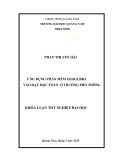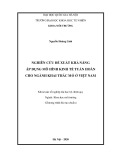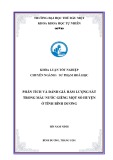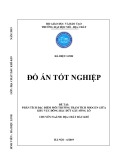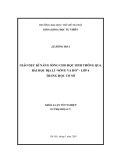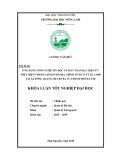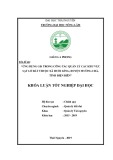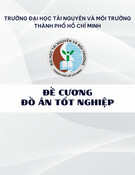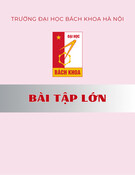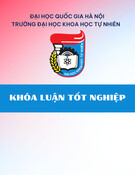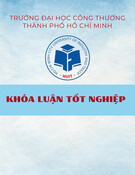MINISTRY OF EDUCATION AND TRAINING UNIVERSITY OF MINING AND GEOLOGY
DAU THANH BINH
RESEARCH ON TECHICAL SOLUTIONS TO BUILD MINERAL RESOURCE MANAGEMENT DATABASE USING WEBGIS TECHNOLOGY
Major : Surveying and Mapping engineering Code
: 9520503
SUMMARY OF TECHNICAL DOCTORAL THESIS
HANOI - 2021
The dissertation is completed at: Department of Imaging and Remote Sensing, Faculty of Geodesy - Map and Land Management, Hanoi University of Mining and Geology
Scientific Supervisors: Assoc. Prof., Dr. Nguyen Truong Xuan Reviewer 1: Prof. Dr. Vo Chi My
Vietnam Association of Georaphy, Cartography and Remotesencing
Reviewer 2: Dr. Tran Trung Anh
Hanoi University of Mining and Gelogy
Reviewer 3: Dr. Dao Ngoc Long
Vietnam Institute of Geodesy and Cartography
The dissertation will be defended before the Academic Review Board at the University level at Hanoi University of Mining and Geology at ..…:……. of date.. ……month..….year…….
The thesis is available at the National Library of Vietnam or the Library of Hanoi University of Mining and Geology.
1
INTRODUCTION 1. The urgency of the thesis
in many resulting
Vietnam has rich and diverse mineral resources. However, the management of mineral resources still has many shortcomings and illegal exploitation activities. limitations; Therefore, the problem of rational management and use of mineral resources for re-investment, towards sustainable development is extremely important, urgent and a national strategy.
Today, with the development of science and technology and the fourth industrial revolution taking place in all fields, including the fields of state management of mineral resources, the application of open source WebGIS platforms in building mineral resource management database is reasonable, suitable as well as to ensure topicality and reliability. Although, there have been a number of studies on solutions based on open source WebGIS technology, but these studies still have some problems such as building solution, asynchronous techniques, and without integration of remote sensing image data processing technology ...
By such facts, the thesis "Research on technical solutions to build mineral resource management database using WebGIS technology" is an urgent issue with practical scientific significance to solve the above situation. 2. The research objectives of the thesis
To establish the scientific basis and methodology to build WebGIS database in order to improve the efficiency of mineral exploitation management and activities. 3. Target and area of this study
- Target of this study: The direct scientific object is to study technical solutions to build WebGIS database for mineral resources classes, suitable for the efficient management of mineral resources in the practical conditions of Vietnam.
- Analysis and synthesis method: Collection of GPS measurement - Area of this study: Research scope of content is open source WebGIS technology and some techniques for extracting mineral information on remote sensing image implemented in Quy Hop district - Nghe An province. 4. Method of research data, remote sensing image data, GIS vector data ...
2
- Remote sensing method: Processing of remote sensing image
- GIS method: processing, editing, spatial analysis of GIS data
technique based on remote sensing
- Modeling method: The research guide in the thesis is modeled to
data is to build potential mineral data layer ... and remote sensing images. - Comparison method: comparing and evaluating the research results on the application of WebGIS technology in database building and mineral resource management; compare results of potential data layer on mineral resources based on information extraction image with information related to mineral resource management, exploitation and use. make it easy to understand and use in the data processing process. - Programming technique: selecting programming languages in combination with libraries to support data processing, designing and installing algorithms to build and test WebGIS systems to build databases and manage documents. raw minerals. 5. The scientific and pratical meaning of this thesis
- Scientific meaning: To establish a scientific basis and technical resource to build WebGIS database for mineral solutions management.
- Practical meaning: The research results can be applied to build WebGIS database for mineral management in general and WebGIS database for Quy Hop district - Nghe An province in particular. 6. Defense thesis and new points of the thesis
Defense thesis 1: The solution of extracting information from remote sensing images combined with GIS analysis based on an open foundation is meeting the topicality and reliability in building mineral resource database.
Defense thesis 2: Open source WebGIS technology is a suitable technical solution satisfying to the management of large database of mineral resources. 7. The new highlights of the thesis - Propose technical solutions to build spatial database of mineral resources from the extraction technique of remote sensing image and GIS analysis based on open platform to serve the problem of monitoring and assessing the current situation. - Build mineral resource management system model based on open source WebGIS platform suitable for managing large database
3
of mineral resource. 8. The layout of the thesis
The thesis is presented in 187 pages, including the preamble, thesis content, conclusions and proposals, author's work list, references, table of contents. The content of the thesis includes 4 chapters with 106 figures and diagrams, and 24 tables/sheets.
CHAPTER 1. OVERVIEW OF RESEARCH MATTERS ON BUILDING WEBGIS DATABASES FOR MANAGEMENT OF MINERAL RESOURCES 1.1. Current situation of mineral resources in Vietnam and Nghe An province 1.1.1. Current situation of mineral resources in Vietnam Mineral resources have strategic significance and serve as a resource for the country's socio-economic development. However, many illegal mineral exploration activities still take place. One of the reasons leading to this situation is not good ability to monitor and manage mineral resources. According to a study by the Institute of Natural Resources Management published in 2013, Vietnam ranked 43/58 in the capacity of mineral governance. 1.1.2. Current situation of mineral resources in Nghe An province
Nghe An is a province with abundant mineral resources compared to many other provinces. Nghe An province currently has 113 mineral mines with large reserves, 171 points of ore. However, besides the positive development, the process of management and exploitation of mineral resources in Nghe An province has revealed many limitations such as:
- Some localities have lax in management of natural recources. - Nghe An mineral resource database includes many categories such as paper maps, documents, decisions, mineral exploration, investigation, mining and processing licenses as well as data on survey results, exploration but stored in many different agencies, not concentrated. Therefore, building a mineral resource database to integrate in a
common management system is very necessary. 1.2. Research situation in the world and in the country 1.2.1. Research situation in the world
Many scientific works have combined remote sensing and GIS to establish potential maps of mineral distribution or assess changes in
4
in
the current state on a large scale. The techniques of extracting mineral information on remote sensing images, GIS analysis combined with scientific analysis the fields of geology, geophysics, geochemistry have created sources of information about potential distribution. mineral resources to assist in the process of surveying, exploring and evaluating the current state of mineral resources. Many scientific studies have proven the usefulness and application of these technologies. These include Kuosmanen - Finnish Geological Survey (1991), Sankaran Rajendran and Sobhi Nasir - Sultan Qaboos Oman University (2013), Seyed Mohammad Bolouki - Faculty of Mining and Metallurgical Engineering, University of Amirkabir technology, Iran (2019) ...
Today, the development of GIS and Web has strongly promoted the development of WebGIS, especially open platforms. Open WebGIS platforms have been applied in the management, analysis, and evaluation of spatial data information based on distributed models (internet, corporate networks ... ...) serving in many different social fields, including the management of mineral resources. These include the researches of Sakhare - Motilal Nehru India National Institute of Technology (2010), Finnian OConnor - Technological University Dublin, Ireland (2011), Miao Liu - National Snow and Ice Data Center of America ( 2012), George Tudor - Romania Geological Institute (2012), Bo Jingfang and Yang Zongxi - China Beijing University of Geosciences (2012), Joel Bandibas - Japan Geological Survey Bureau under the Institute of Science and Japan National Advanced Industrial Technology (2013), Ranka Stankovic - Faculty of Mining and Geology of Belgrade University, Serbia (2016), Nan Li - Institute of Mineral Resources, Beijing Institute of Geosciences China (2018), Joel Bandibas and Shinji Takarada - Japan Geological Survey Department under the Institute of Science and Japan National Advanced Industrial Technology (2019) ... 1.2.2. Research situation in the country
locating has effectively supported
researching and applying With the strong development of geospatial technologies such as remote sensing, GIS, the collection, analysis, and processing of information of the mineral resources data; from there as a foundation to build a database of mineral resources. Up to now, there have been a number of scientific works remote sensing and GIS technologies to collect and process information and data that are
5
directly or indirectly related to information sources of environmental resources in general, as well as mineral resources in particular. These include the studies of Truong Chi Quang - Can Tho University (2013), Le Van Thanh - Faculty of Environment and Natural Resources, Can Tho University (2014), Nguyen An Binh - Academy of Science and Vietnam Technology (2015), Le Xuan Anh (2016), Nguyen Hoang Khanh Linh - Hue University of Agriculture and Forestry (2017), Nguyen Hai Hoa - Forestry University (2019) ... 1.3. Evaluation of research results
The results of the above studies have shown some remaining limitations as follows:
- The input data sources are only layers of mineral information, thematic maps, and mineral potential data layers based on remote sensing images have not been built.
- These studies mainly use WMS standard to represent maps. However, this is an old standard that cannot accommodate real-time mapping of map data.
- These studies have not integrated supporting platforms for spatial data processing such as remote sensing image processing, GIS spatial analysis with WebGIS technology platforms. 1.4. Issues being developed in the thesis
- Propose technical solutions to build spatial database of mineral resources from remote sensing image extraction technique and GIS analysis based on open foundation to serve the problem of monitoring and assessing the current situation. - Build a model of a large database management system of mineral resource based on an open WebGIS platform.
CHAPTER 2. APPLIED SCIENCE BASIS OF OPEN SOURCE PLATFORM TO BUILD OF MINERAL RESOURCE MANAGEMENT DATABASE
2.1. Open source WebGIS platform 2.1.1. WebGIS overview
WebGIS is a combination between Web and GIS. This is a form of distributed geographic information system, including geospatial database, Map Server (GIS server) and client computer. In 1993, Xerox Corporation Research Center (PARC) has built the world's first mapping Website, marking the birth of WebGIS.
6
2.1.2. Open source WebGIS development platform
GeoServer – Map server Geoserver is an open source Web mapping server for the purpose of connecting available geographic information to WebGIS websites using the OGC open standard. In 2001, GeoServer was developed by the Open Planning Project. Currently, in addition to the GeoServer, there are also a number of other map server software such as MapServer, Mapnik, MapGuide, QGIS Server, ArcGIS Server. Among these map servers, the most famous are GeoServer, MapServer, ArcGIS Server softwares.
PostgreSQL – database management system PostgreSQL is an object relation database management system that has built from the POSTGRES project at the University of California. Currently, PostgreSQL has become the most popular open source database management system. PostgreSQL started to develop in 1986. The concepts, the data model, the system design, the rules, and the architecture of the storage manager are described in PostgreSQL. PostgreSQL has been used to deploy many different applications in production and research such as: financial data analysis system, jet engine performance monitoring project, astronomical tracking database ... PostgreSQL is easy to set up and install. It provides support for SQL and NoSQL. PostgreSQL has been widely adopted by the industry in recent years. Some leading companies in the world are using PostgreSQL such as Instagram, NextFLIX, Cybertec ...
PostGIS – Spatial database PostGIS is a spatial database that has developed by Research Inc in 2001. PostGIS supports geographic data types such as vector, raster; functions, operators, and spatial indices. PostGIS provides features such as: - Support processing spatial features of points, lines, polygons, polypoints, polylines, poly regions, geometrical assemblies.
- Set up spatial projections and transform coordinate systems - Handle spatial measurements such as area, distance ... - Set up spatial indexes for high performance queries. - To handle calculations of geospatial set such as union, difference, symmetric difference and buffers. - Execute spatial queries based on structured query language (SQL)
7
QGIS/GRASS – Processing and editing of geospatial data QGIS is an open source GIS software suite that runs on Linux, Unix, Mac OS and Windows operating systems. QGIS is capable of building, editing and printing digital maps like ArcGIS commercial software. QGIS supports the ability to process raster and vector files; connecting spatial databases such as PostGIS, SpatiaLite, Oracle, DB2 ... QGIS also supports data processing directly from GPS and supports field data processing. Some main functions of QGIS: - Display and stack vector and raster data in different formats (.tab, .shp, .gpx ...). - Editing and printing of maps. - Access the database to build report forms/sheets - GRASS satellite image digitization and interpretation tools. - Tools for processing data directly from GPS. 2.2. Several data processing techniques based on the open WebGIS model 2.2.1. WMS
WMS is a standard that developed by OGC in 1999 to provide geographic reference map images on the internet. WMS provides raster image data in many different resolutions and formats, used in many GIS applications. WMS parameters allow the user to select maps of different sizes and resolutions and can be represented at any scale. To determine the scale of the map in use, the server performs DPP calculation for the requested image and finds the nearest tile zoom level, according to the following formulas:
𝐷𝑃𝑃 = (2.1)
(2.2) 𝐷𝐷𝑃(cid:3051) =
(cid:3005)(cid:3017)(cid:3017)(cid:3299)(cid:2878)(cid:3005)(cid:3005)(cid:3017)(cid:3300) (cid:2870) 𝜆(cid:2869) − 𝜆(cid:2868) 𝑊 𝜃(cid:2869) − 𝜆(cid:2868) 𝐻
(2.3) 𝐷𝐷𝑃(cid:3052) =
𝜆(cid:2869) : map viewport's maximum longitude 𝜆(cid:2868) : map viewport's minimum longitude 𝜃(cid:2869) : map viewport's maximum latitude 𝜃(cid:2868) : map viewport's minimum latitude W: width of the map viewport in pixels H: height of the map viewport in pixels The calculation of the number of tiles needed for the map image
8
creation is based on the following formula:
𝐷𝑃𝑃 = 360.0 2(cid:3036) 𝑝 (2.4) In which: p – the number of pixels on that tile, i – zoom level 2.2.2. WFS
WFS is a standard of OGC that published in 2005. WFS describes operations on geometrical features such as points, lines, and regions. WFS supports the following activities:
- GetCapabilities: defines the supported FeatureTypes. - DescribeFeatureType: find the available properties for the FeatureTypes - GetFeature: get the FeatureType's properties 2.2.3. TMS
TMS is a specification for tile Web maps that developed by OSGeo in 2006. The horizontal distance represented by each square tile is measured along the latitude at a certain latitude and calculated by the formula:
(2.5) 𝑆(cid:3047)(cid:3036)(cid:3039)(cid:3032) = 𝐶 × cos(𝑙𝑎𝑡𝑖𝑡𝑢𝑑𝑒) 2(cid:3053)(cid:3042)(cid:3042)(cid:3040)(cid:3039)(cid:3032)(cid:3049)(cid:3032)(cid:3039)
= 𝐶 × In which, C is the circumference following the equator of the earth. Since the tiles are 256 pixels in size, then the horizontal distance represented by one pixel is 𝑆(cid:3043)(cid:3036)(cid:3051)(cid:3032)(cid:3039) = 𝑆(cid:3047)(cid:3036)(cid:3039)(cid:3032) 256 cos(𝑙𝑎𝑡𝑖𝑡𝑢𝑑𝑒) 2((cid:3053)(cid:3042)(cid:3042)(cid:3040)(cid:3039)(cid:3032)(cid:3049)(cid:3032)(cid:3039)(cid:2878)(cid:2876)) (2.6) The number of rows and columns is determined corresponding to each zoom level by the formula:
𝐶(cid:3036) = 2(cid:3036) (2.7) 𝑅(cid:3036) = 2(cid:3036)(cid:2879)(cid:2869) (2.8) The relationship between the tile address, geographic coordinates and zoom level is determined by the formulas:
𝜆(cid:3040)(cid:3036)(cid:3041) = 𝑐 360.0 2(cid:3036) − 180.0 (2.9)
9
𝜆(cid:3040)(cid:3028)(cid:3051) = (𝑐 + 1) 360.0 2(cid:3036) − 180.0 (2.10)
𝜃(cid:3040)(cid:3036)(cid:3041) = 𝑟 360.0 2(cid:3036)(cid:2879)(cid:2869) − 90.0 (2.11)
𝜃(cid:3040)(cid:3028)(cid:3051) = (𝑟 + 1) 360.0 2(cid:3036)(cid:2879)(cid:2869) − 90.0 (2.12)
In which: c – column index; r – row index; 𝜆 – longitude; 𝜃 –
latitude; i –zoom level 2.2.4. WMTS
WMTS is a standard that developed by OGC to provide map tiles that are calculated before runtime or calculated over the Internet. WMTS was first released in 2010. The WMTS standard provides digital maps using predefined image fragments. Compared with WMS, WTMS has an advantage in that each time the user moves the display area, most of the related tiles are still displayed, while new tiles will be searched and loaded. This greatly improves the map rendering speed compared to single map fetching for the entire display area. It allows to calculate before rendering the tiles using the parallel technique. 2.2.5. GiST spatial indexing technique in PostGIS
The Generalized Search Tree (GiST) was originally described by Hellerstein. It is a structure that provides a balanced and extensible tree access approach to indexed data types. In addition to providing scalability for data types, GiST also consolidates different structures into the ones used for today's popular data types.
Figure 2.15. The Generalized Search Tree (GiST) 2.3. Some algorithms extracting mineral information on remote sensing image 2.3.1. Mineral index
The band ratio between the two image bands K and L is defined
10
as follows:
Bij = (2.13) B(cid:2919)(cid:2920)(cid:2895) B(cid:2919)(cid:2920)(cid:2896) BijK - pixel brightness value (i, j) brand K; BijL - pixel brightness value (i, j) brand L.
Mineral index is a calculation on image brands to highlight reflective characteristics of mineral layers based on the image brand ratio technique. Below are some types of mineral indexes that are commonly used in remote sensing. Clay Minerals Ratio (CMR) Clay minerals characterize hydrothermal changes in rocks and they are strongly absorbed within a spectrum of about 2.2 μm, whereas strong reflections are in the 1.6 μm spectrum. Thus the reflection spectrum of clay minerals can be enhanced by implementing the Shortwave Infrared (SWIR) ratio
𝐶𝑀𝑅 = (2.14) 𝑆𝑊𝐼𝑅1 − min (𝑆𝑊𝐼𝑅1) 𝑆𝑊𝐼𝑅2 − min(𝑆𝑊𝐼𝑅2) + 1
In which, SWIR1: 1.55-1.75 µm; SWIR2: 2.08-2.35 µm. Iron oxide ratio index (IORI)
Iron oxide is one of the minerals commonly found in the natural environment. Using the ratio between red and blue image brands will enhance the reflectivity of iron oxides:
𝐼𝑂𝑅𝐼 = (2.16) 𝑆𝑊𝐼𝑅 𝑁𝐼𝑅
In which, SWIR: 1.55-1.75 µm; NIR: 0.76-0.9 µm. 2.3.2. The PCA Method
The PCA method is a multivariate statistical method that introduced by Pearson (1901). The PCA method has been widely used in remote sensing to create mineral geological maps. During the implementation of the PCA, it is necessary to calculate a number of image statistics.
(2.18) μ(cid:2919) = 1 n − 1 Image average value M(cid:2908) is the vector representing the mean of the image X, with form: M(cid:2908) = (μ(cid:2869) μ(cid:2870) … μ(cid:2923))(cid:2904) (cid:2924) (cid:3533) x(cid:2919)(cid:2920) (cid:2920)(cid:2880)(cid:2869)
11
(2.19) 𝑉𝑎𝑟(cid:3036) = 𝜎(cid:2870) = 1 𝑛 − 1 In which, 𝜇(cid:3036) is the average value of the ith image band. Value of image variance 𝑉𝑎𝑟(cid:3025) is the vector representing the mean of the image X, with form: 𝑉𝑎𝑟(cid:3025) = (𝑉𝑎𝑟(cid:2869) 𝑉𝑎𝑟(cid:2870) … 𝑉𝑎𝑟(cid:3040))(cid:3021) (cid:3041) (cid:2870) (cid:3533)(cid:3435)𝑥(cid:3036)(cid:3037) − 𝜇(cid:3036)(cid:3439) (cid:3037)(cid:2880)(cid:2869)
(cid:3041)
Matrix of covariance images Covariance between two image brands k and t, denoted by 𝑐(cid:3038)(cid:3047) is calculated by the formula:
(cid:3037)(cid:2880)(cid:2869)
(cid:4685) (2.20) 𝑐(cid:3038)(cid:3047) = (cid:4684)(cid:3533)(cid:3435)𝑥(cid:3038)(cid:3037) − 𝜇(cid:3038)(cid:3439)(cid:3435)𝑥(cid:3047)(cid:3037) − 𝜇(cid:3047)(cid:3439) 1 𝑛 − 1
Through linear algebraic transformations, the covariance matrix 𝐶𝑜𝑣(cid:3025) c can be converted to a diagonal matrix with n non-negative values on the main diagonal.
0 𝜆(cid:2869) G = (cid:4684) (cid:4685) ⋱ 0 𝜆(cid:3041) 𝜆(cid:2869) > 𝜆(cid:2870) > ⋯ > 𝜆(cid:3041) > 0 𝑣ớ 𝑖 𝑛 ≤ 𝑚
Value 𝜆(cid:2919) is the ith specific value, representing the amount of information concentrated in 𝑃𝐶(cid:3036). i. The formula for calculating the amount of information concentrated in the i main component image is determined as follows:
(2.21) inf(𝑃𝐶(cid:3036)) = 𝜆(cid:3037) 𝜆(cid:3036) (cid:3041) ∑ (cid:3037)(cid:2880)(cid:2869) 2.3.3. The DPCA method
In remote sensing image processing, the DPCA method was developed by Fraser and Green in 1987 when they studied the effects of vegetation cover on hydroxyl-bearing minerals. DPCA maps specific groups of information to a major component based on spectral reflectance characteristics. The difference between DPCA and PCA is the pre-selective input to the DPCA method. In the DPCA method, prior to proceed PCA, the baseline data is preliminarily extracted. Preliminary extraction will be performed by channel ratio measurements. Thus, DPCA is a combination of two
12
methods of band ratio and PCA:
𝐷𝑃𝐶𝐴 = [𝐵𝑟𝑎𝑛𝑑 𝑟𝑎𝑡𝑖𝑜] + 𝑃𝐶𝐴 (2.28) CHAPTER 3. TECHNICAL SOLUTIONS TO BUILD A WEBGIS DATABASE FOR MANAGEMENT OF MINERAL RESOURCES
3.1. The procedure on building and managing a database of environmental resources
On May 28, 2014, the Minister of Natural Resources and Environment issued Circular No. 26/2014/TT-BTNMT on the procedure and economic-technical norms for building the natural resource and environment database. The process of building software applications must comply with ISO standards in GIS and spatial database such as GML metadata standard, open data representation standard such as WMS, WFS ... In the project for building the national database for natural resources and environment from 2010 - 2014, the Department of Information Technology - Ministry of Natural Resources and Environment has developed a technology solution for the management system of natural resources and environment database, including:
- Invest in a unified software system (copyrighted): Database management system (Oracle, DB2, MS SQL Server, ..); Geographic information technology (GIS): ArcGIS (ArGIS Server, ArcSDE, ArcGIS Engine); Electronic signature service; - Standard data and information exchange formats: WMS, WSDL, XML, GML ...
- Combine with open solutions: PostgreSQL, PostGIS, ... Thus, it can be said that in the process of building and developing management systems for natural resources and environment databases, state government agencies have also focused, paid attention and researched to integrate solutions and open GIS platforms. 3.2. Overall solution model for building and managing mineral resource database
The author has built a solution model to build and manage a mineral resource database based on open source WebGIS technology as shown in Figure 3.3. For design of the solution for building and managing mineral resource database, the author has complied with
13
the regulations on GIS data standards in building natural resource and environmental databases in general, as well as mineral resources in particular, for example: National technical regulations on basic geographical information standards issued together with Circular No. 02/2012/TT-BTNMT of the Minister of Natural Resources and Environment ... Solutions proposed by author include the following compositions: Human; mineral recourses database building system based on open source GIS platform; mineral resources management system is based on open source WebGIS platform; Mineral resource database.
Figure 3.3. Overall model for building and managing mineral resource database
System of building mineral resource database based on open source GIS platform: implementing the editing, building and standardizing information and data sources related to mineral resources.
14
Figure 3.5. Model of technical solutions of the system to build a mineral resource database based on open source GIS platform The mineral resource management system based on the open source WebGIS platform: includes client-side and server-side applications as shown in Figure 3.7: Client-side mineral resource management system, Server-side mineral resource management system
Figure 3.7. The technical solution model of the mineral resource management system based on the open source WebGIS platform
15
Mineral resource database: Figure 3.8 is the technical solution for storing mineral resource database, including: tabular database stored on PostGIS / PostgreSQL database server: storing vector data layers; File-type databases are stored on file servers such as remote sensing image data, basemap data, textual data ...
Figure 3.8. Technical solutions for mineral resource database storage 3.3. Technical solutions for building mineral resource database 3.3.1. Build vector-type map data layers
The vector-type map data layers are built including mineral layers, layers, hydrological layers, traffic deposits, boundary residential layers, real overlay …
16
Figure 3.11. Procedure on building of vector-type data layers 3.3.2. Build mineral mining spatial data layer
Figure 3.13. Procedure on building of mineral mining data layers.
17
3.3.3. Build image data layers
Figure 3.17. Procedure on building remote sensing image layers solutions for building mineral resource 3.4. Technical management systems
Figure 3.27. Technical solution model for mineral resource management system based on open source WebGIS platform
18
This system includes: client-side processing layer: developed based on programming languages such as javascript, html, css and open source WebGIS development platforms such as OpenLayers, GeoExt; Server-side processing layer: developed based on programming languages such as php, javascript, sld, xml and open source Web servers like Apache, open source map server GeoServer. 3.4.1. Decentralized module With the mineral database management system, depending on the object, it is possible to access the system with different rights. Table 3.1. System access rights to the object groups
Use rights Manager Staff Investigator People
Data query
Data input/entry
Data update
Data delete
Analysis and statistics
Data output/ Export 3.4.2. Data update module
Figure 3.28 Data update process 3.4.3. Data query module
19
Figure 3.30. Data query process 3.4.4. Data input/entry module
Figure 3.31. Diagram of the process of data entry on the WebGIS system for mineral resource management CHAPTER 4. APPLICATION OF THE TECHNICAL SOLUTIONS TO BUILD A WEBGIS DATABASE FOR NATURAL RESOURCES MANAGEMENT IN QUY HOP DISTRICT, NGHE AN PROVINCE 4.1. Experimental area
Quy Hop is a mountainous district in the northwest of Nghe An province. Quy Hop has many precious minerals such as gold, gemstones, tin, antimon, ... Particularly, tin ores have a high content. 4.2. Build Quy Hop mineral resource database Mineral resource database includes geological map data, mineral
20
potential map; maps of the planning for mineral survey, exploitation, processing and use; maps of prohibited areas and areas temporarily banned from mineral activities; map of the location of mineral mines ... 4.2.1. Build vector spatial data layers
To build GIS vector information layers on mineral resources, the author used 6 map pieces at the scale of 1: 50,000 with the numbers E-48-18-B, E-48-18-D, E-48-19-A, E-48-19-B, E-48-19-C, E-48-19- D respectively. 4.2.2. Build attribute data tables
Attribute data tables are designed to store information related to the mineral mine administrative management activities. These data tables include: mining enterprise data, data on mineral mine inspection activities, data on violation handling. 4.2.3. Build raster spatial data layers
- Building remote sensing image color composite layer in Quy Hop district: Some commonly used color combinations such as natural color combinations, infrared color combinations, agricultural color combinations ... - Building data layer on potential of rock minerals in Quy Hop district area from satellite image Landsat-8:
Figure 4.13. Overlay of mineral rock potential data layer with the mineral mine data layer
The rock mineral potential data layer was built from Landsat-8 satellite image data based on DPCA method. The results after the DPCA implementation obtained the potential data layer about the quarries as shown in Figure 4.13. In which, red color represents
21
potential areas for quarries. This information layer is overlaid with the vector layer of rock mine quarries in Quy Hop district. 4.3. Experimental evaluation of some big data processing techniques 4.3.1. Multi-threading technique for large size image processing
(cid:3041)
Calling T is the execution time for a single-threaded computing program. Suppose the B multichannel satellite image data set is divided into n data blocks B1, B2,…, Bn. Then: 𝑠𝑖𝑧𝑒(𝐵(cid:2869)) ≈ 𝑠𝑖𝑧𝑒(𝐵(cid:2870)) ≈ ⋯ ≈ 𝑠𝑖𝑧𝑒(𝐵(cid:3041))
(cid:3036)(cid:2880)(cid:2869)
𝑠𝑖𝑧𝑒(𝐵) = (cid:3533) 𝑠𝑖𝑧𝑒(𝐵(cid:3036)) (4.1)
Calling t1, t2,…, tn respectively is the processing time of thread 1, thread 2, ..., thread n. calling t is the processing time of a multithreaded program. Then: 𝑡 = max{𝑡(cid:2869), 𝑡(cid:2870), … , 𝑡(cid:3041)} (4.2)
(cid:3021) (cid:3041)
(4.3) 𝑡 ≈
The experiment was conducted for the problem: calculating the
iron oxide index Table 4.12. Results of multithreading calculation for iron oxide index
No. File size (MB) 1 thread (ms) 2 threads (ms) 4 threads (ms)
30 104 52 26 1
72 246 134 68 2
108 370 187 93 3
180 613 307 154 4
224 763 380 192 5
400 1364 680 341 6
4.3.2. Building a GiST index for big spatial database The study was conducted on 4 scenarios and the results are illustrated in table 4.14 and figure 4.17
22
Table 4.14. Results sheet with ST_Dwithin between line and point data sets
NĐK-Bản ghi TGiST NTK-Bản ghi No. TNo_GiST(ms) (pointm) (ms) (line)
1 43,775 477 15 405
2 79,529 2,323 27 758
3 118,774 15,166 47 1,068
4 849,199 2,401 63 6,396
5 1,047,502 2,628 67 9,472
6 1,646,394 8,510 85 10,319
7 2,693,896 8,510 94 17,226
From the research results, it can be seen that for big spatial databases, building the GiST spatial index will make the calculation and querying of data much fast
Figure 4.17. The graph shows the performance results of spatial queries in case of using / not using the GiST index. 4.4. WebGIS trial building for Quy Hop mineral resources management 4.4.1. Building mineral resource spatial database Mineral resource spatial database is built based on structured
23
query language (SQL). It also can be done using PostGIS Shapefile Import / Export Manager. The tables of the mineral resource spatial database in PostGIS can be updated, modified and standardized on QGIS software.
Figure 4.19. Using QGIS to edit the spatial mineral resource database 4.4.2. Set up WebGIS system to manage mineral resources on GeoServer
Some steps to set up GeoServer map server for WebGIS system to manage mineral resources: Create new workspaces, Create Stores, Create Layers, Create Styles for Layer. 4.4.3. Build WebGIS interface for mineral resource management
Based on the above design analysis, the author has developed a trial WebGIS system for mineral resource management in Quy Hop district - Nghe An province.
Figure 4.22. The main interface of WebGIS system for mineral resource management The main interface is divided into 5 parts: Part 1 (symbol 1): is
24
the area to manage the main functions; Part 2 (symbol 2): is the area containing the functions to interact with the map; Part 3 (symbol 3): is the map representation area; Part 4 (symbol 4): is the area to manage map data layers; Part 5 (symbol 5): is the area that displays information about mineral quaries.
CONCLUSION AND PROPOSAL 1. Conclusion
The problem of building mineral resource management database that plays an important role in the strategy of sustainable socio- economic development because of the current state in our country, the mining and mineral management are not really effective and in depth.
Technical solutions for building a spatial database of mineral resources from remote sensing image extraction techniques and GIS analysis based on an open foundation such as QGIS / GRASS ... are completely suitable and feasible in support of exploration, monitoring and evaluation of mineral resource actuality.
The mineral resource management system based on the open source WebGIS platform is one of the reasonable and feasible solutions. With these solutions, WebGIS systems for mineral resource management can be built not only suitable for small, medium scale but also on large scale. 2. Proposal The results have research shown the
feasibility and reasonableness of the proposed technical solution in the problem of building mineral resource management database, being experimental in Quy Hop district - Nghe An province. The results of this research can be completely applied for practical deployment with the large management scale and scope.
25
LIST OF THE PUBLICATION 1. Dau Thanh Binh, Cao Xuan Cuong, Nguyen Xuan Phuong (2013), Research on building a database for environmental management in Cam Pha coal region - Quang Ninh province, Mining Industry Journal, Hanoi.
2. Pham Thi Lan, Le Thi Thu Ha, Nguyen Van Loi, Doan Thi Dung, Dau Thanh Binh (2013), Classification of coatings by object- oriented method on Alos image in Giao Thuy area - Nam Dinh province, Mining Industry Journal, Hanoi.
3. Dau Thanh Binh, Trinh Le Hung (2017), Application of fuzzy clustering to assess the variation of coatings of the mining area in Quy Hop district, Nghe An province from Landsat photos, Mining Industry Journal, Hanoi, ISSN 0868 - 7052, No. 2/2017, p. 22-27.
4. Nguyen Truong Xuan, Nguyen Thi Mai Dung, Tran Thi Hai Van, Tran Mai Huong, Diem Thi Thuy, Dau Thanh Binh (2017), WebGIS application development for natural resource and environmental information systems in Phu Tho province, Journal Mining Science - Geology Journal 58 (5), p. 1-9.
5. Dau Thanh Binh, Nguyen Sach Thanh, Nguyen Nhu Hung (2020), Multi-threading technical study in calculating mineral indexes on Landsat-8 satellite image data, Mining Industry Journal No. 4-2020, p. 73 - 7.
6. Nguyen Sach Thanh, Dau Thanh Binh, Nguyen Nhu Hung (2020), Research on spatial indexing techniques in building mineral database, Journal of Ho Chi Minh City University of Education, ISSN 1859-3100, 2020.
7. Dau Thanh Binh, Nguyen Sach Thanh, Nguyen Nhu Hung, Do Van Duong (2020), Open source WebGIS application in mineral resource management: typical study in Quy Hop area, Nghe An province, No. 32 - 2020 , tr. 63 - 70..


